Beyond Borders: Cultural Mobility in Precarious Times

Drawing on the author's experience as an arts manager in Yogyakarta, Indonesia, this article reflects on key insights from On the Move’s Cultural Mobility Forum 2025 in Riga, Latvia and explores how these discussions shape our understanding of cultural mobility in these precarious times. While emphasising the critical role of mobility for artists, the article also highlights the often-overlooked need for equal access to international opportunities for other cultural professionals — such as arts managers, curators, and cultural producers — whose work are essential to the sustainability and success of cultural exchange.
Supported as part of the Arts Journalism Matters: On the Ground series, the article calls for a more inclusive approach to cultural mobility, one that addresses the structural inequalities faced by all contributors within the arts ecosystem.
As part of its multiannual programme, On the Move, an international information network dedicated to artistic and cultural mobility, organises the annual Cultural Mobility Forum to explore key trends in international artistic and cultural mobility. Designed with members and partners, and co-funded by the European Union, the forum aims to foster dialogue on creating more inclusive and sustainable mobility. The 2025 edition in Riga, Latvia, focuses on how global challenges — such as digital development, mobility justice issues, climate concerns, and international world uncertainties — affect the careers of young and emerging arts workers.
Prior to my departure to Riga, Latvia, to participate in the Cultural Mobility Forum 2025, I took part in one of the pre-event programmes, Webinar #3: The International Mobility of Young Arts Workers on 23 April 2025. The session provided a first discussion to understand the global mobility landscape for young and emerging arts workers. The presentation of the Cultural Mobility Yearbook 2025 by Dr Claire Rosslyn Wilson, Data Collector and Analyst for On the Move, highlighted two interesting points: residency as the most preferred form of mobility (49.8%) and artists as the dominant group accessing international opportunities (68.5%). These findings, with reference to my personal experience as an arts manager in Yogyakarta, Indonesia, prompted a critical reflection on the key points raised in the Cultural Mobility Forum 2025.
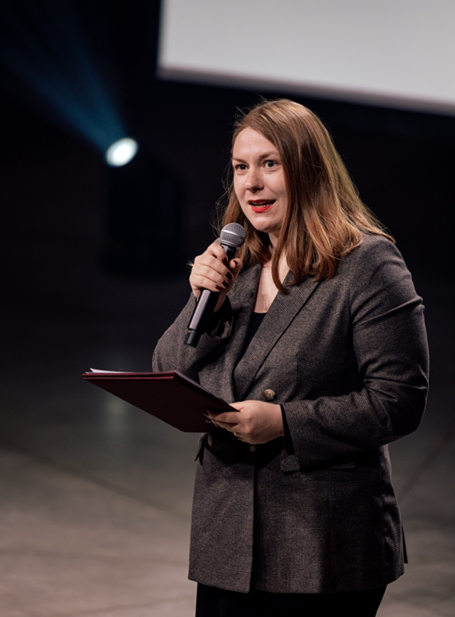 | 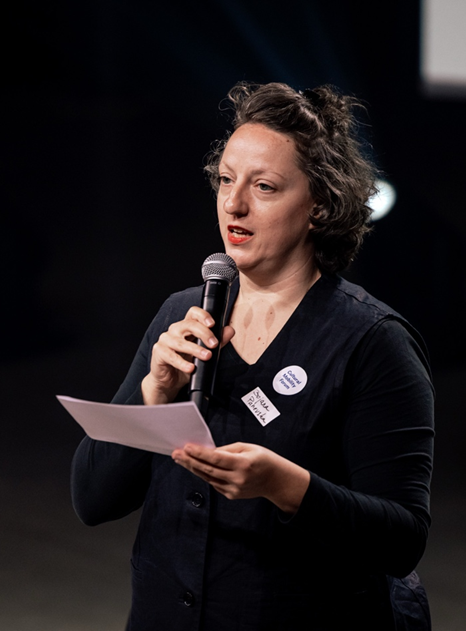 |
1. Opening words by Līna Birzaka-Priekule, Head of the Minister's Office, Ministry of Culture, Latvia and Bojana Panevska, President, On the Move. Photo © Lauris Vīksne
Shifting the paradigms and narratives of cultural mobility
Hearing that residencies have become the most popular form of cultural mobility does not surprise me. In 2017, while I was still working at Cemeti-Institute for Art and Society, we organised a forum called Forms of Exchange: (Re)producing Residencies to reflect on more than ten years of experience running residency programmes. We invited several residency managers, artists, and curators. These include Lifepatch, MES 56, Ace House Collective, and other initiatives. Since early 2010, more than 20 art spaces and artists' collectives in Yogyakarta have been managing residency programmes with various formats, curatorial approaches, and funding schemes.
For the local arts community, residency plays an important role as a platform for cultural exchange, the development of artistic practice, and the experimentation of work. Yet the narrative of cultural mobility in the form of residency still focuses on artists, as written in the Cultural Mobility Yearbook 2025.
The first panel, Arts Education and Cultural Management Programmes: Embedding the Internationalisation of Practices, explore how arts education institutions, cultural management programmes and life-long learning initiatives integrate internationalisation into their curricula. Paolo Montemurro, the founder of Materahub, Italy, and Aparajita Dutta, the Head of International Affairs at the Royal Academy of Art The Hague, the Netherlands, reflected on the role of educational leadership in supporting cross-border creative mobility and emphasised the need to better equip students for real-world professional contexts. At the opening of the first panel, Dr Dea Vidović of the Institute for Development and International Relations, IRMO, Zagreb, Croatia called for a paradigm shift in how we understand cultural mobility — not merely as physical movement, but as a collective learning process that demands mindset shifts, skill-building, supportive infrastructures, and critical awareness of access inequalities. Her perspective resonated deeply with my experience managing artist-in-residence programmes, where I strive to foster meaningful cultural exchange, yet often find myself excluded from similar mobility opportunities.
This disparity reflects a broader systemic issue: arts managers and other cultural producers, despite being essential to cultural ecosystems, are frequently overlooked in cultural policies and mobility frameworks.

2. Dr Dea Vidović (the Institute for Development and International Relations, IRMO, Zagreb, Croatia) at the opening of the first panel, 'Arts Education and Cultural Management Programmes: Embedding the Internationalisation of Practices'. Photo © Lauris Vīksne
In Indonesia, artists benefit from formal recognition in administrative systems, allowing their profession to be listed on identity cards and taxpayer IDs. This status grants them access to state support, such as healthcare, social security, subsidies, and tailored cultural policies. In contrast, other cultural producers like project managers, curators, and technicians remain less visible in these systems, despite their critical responsibilities in managing international logistics, fostering cross-cultural collaboration, and sustaining international arts programmes. Without equitable access to resources and protections, their contributions to cultural mobility remain undervalued and precarious — despite being essential to making such exchanges possible, fair, and sustainable.
Paolo Montemurro of Materahub, Italy, shared a key insight from their capacity-building programme:
Mobility should benefit not only those who travel, but also those who remain. This highlights the responsibility of mobile individuals to share knowledge with their home communities.
An illustrative example can be seen in Yogyakarta, where art handlers returning from international institutions bring back valuable expertise. By freelancing or starting small businesses, they support artists in shipping works abroad and raise technical standards in exhibitions, which ultimately enriches the local arts ecosystem through shared experience.
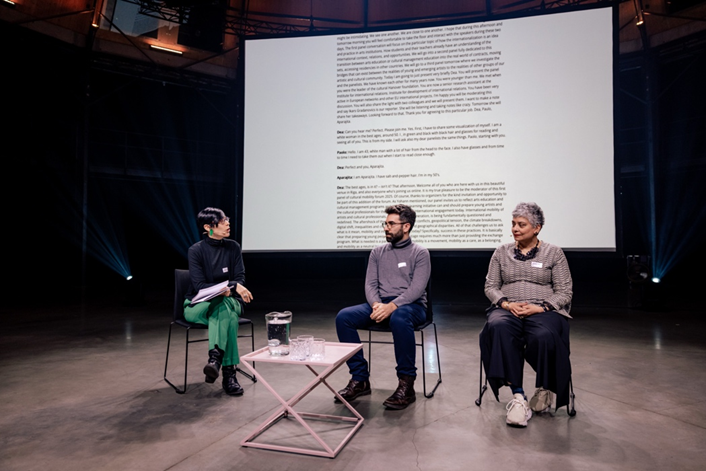
3. Panel 1. 'Arts Education and Cultural Management Programmes: Embedding the Internationalisation of Practices', featuring Paolo Montemurro (Materahub, Italy) and Aparajita Dutta (the Royal Academy of Art The Hague, the Netherlands), with moderator Dr Dea Vidović (the Institute for Development and International Relations, IRMO, Zagreb, Croatia). Photo © Lauris Vīksne
The decision of local art handlers to work with international companies reflects a strategic approach to building mobility-based careers aligned with professional growth — echoing Paolo Montemurro’s view on choosing mobility forms that match one’s development needs. For arts managers or festival workers, international internships offer valuable opportunities to sharpen practical skills and navigate diverse working environments. My experience with Kelola Art’s National Internship at Common Room Networks Foundation, Bandung, in 2008, was formative. I vividly recall how exhibition openings differed: formal speeches in Bandung contrasted with Yogyakarta’s more fluid approach of brief introductions and local performances. These contrasts helped me understand how organisational culture shapes how art is presented and experienced. I also learned how a well-organised system — clear timelines, task divisions, and effective internal communication — fosters a more supportive workplace. This helped me realise that professionalism was more than just following formal standards, but also about contextual awareness and cultivating fair, collaborative teamwork.
Redefining what it means to be ‘international’ and ‘professional' in the global ecosystem
The second panel, Transitioning to the International Arts & Culture Ecosystem: Revisited Motivations and Challenges, examine the challenges young artists and cultural producers face as they transition from education to the professional world. Adam Svoboda, the Head of Production of Prague Quadrennial, Prague, Czech Republic and Jennifer Lee, the Programme Manager for Fellowships & Training at Mekong Cultural Hub, Taiwan, shared insights from their own career transitions, highlighting the complexities of navigating the realities of cultural work. Their reflections prompted a deeper consideration of what it means to be 'international' and 'professional' in arts and cultural practice today.

4. Panel 2. 'Transitioning to the International Arts & Culture Ecosystem: Revisited Motivations and Challenges,' featuring Adam Svoboda (Prague Quadriennale, Czech Republic) and Jennifer Lee (Mekong Cultural Hub, Taiwan), with moderator Maïa Sert (ANdÉA-National Association of Higher Schools of Art, France). Photo © Lauris Vīksne
The term ‘professional’ in Indonesia has become an exclusive construct, tied to access, certification, and a specific style of work. Since the launch of Undang-Undang Pemajuan Kebudayaan (the Cultural Development Law) in 2017, the government has initiated a certification programme to enhance professional recognition and assess competencies in arts management. While various Lembaga Sertifikasi Profesi (Professional Certification Bodies) have been established to support this initiative, I find the programme in need of further development. It risks marginalising arts workers rooted in local traditions, experimental practices, or non-academic pathways, as the certification standards often fail to reflect the diversity of artistic praxis. In addition, the administrative and technical demands of the programme can further exclude those whose work do not fit conventional frameworks, especially if facilitators lack an understanding of the complex, context-driven nature of artists' practices.
Like many arts managers in Indonesia, my path was organic and self-taught, starting as a volunteer at local arts events, without formal training in the arts. At that time, there were no formal and structured educational pathways that specifically supported this career path. Thus, organisational experience on campus and in the neighbourhood served as the earliest and most tangible cultural capital. This was also the case with my colleagues, as young artists at the beginning of their careers, who, despite studying at art schools, still needed spaces to bridge theory with real-world practice. Fortunately, in the early 2000s, many alternative art spaces emerged as a response to the post-reform socio-political conditions and the lack of institutional support for experimental practices. These spaces became communal living spaces that brought together the arts community with academics, writers, and researchers, and helped young artists develop their methods.
Just as Jennifer Lee, Mekong Cultural Hub, developed personal tools to navigate cultural stakeholders and assert her values, local arts communities have cultivated their own sense of professionalism, rooted in non-formal, community-based, and lived experiences.
While collective working methods are often seen as ‘unprofessional’ by institutional standards, in Southeast Asia, they remain vital strategies for navigating limited resources in the absence of cultural infrastructure and policies. In a competitive arts landscape, collective work provides options and possibilities to build power from below, share resources, strengthen solidarity, emotional support, and grassroots resilience.
Echoing the experiences of Mekong Cultural Hub participants as shared by Jennifer, where funding is scarce, collectives serve as spaces of care, mutual support, and survival — often more meaningful than formal structures themselves.
Under financially and socially precarious conditions, the pursuit of visibility — as a marker of professionalism and a path to international recognition — poses yet another challenge for young and emerging arts workers. Unequal access to networks, platforms, and institutions often hinders their ability to perform and gain recognition, while existing systems tend to favour the established. For some, visibility itself can be risky — particularly when their work engages with minority identities or sensitive narratives. As a result, strategies for safe and sustainable visibility often depend on community support, collective practices, and more inclusive alternative spaces.
As cultural mobility becomes increasingly complex, professionalism no longer means simply adhering to globally recognised standards or work formats. We often overlook the fact that such standards are rooted in well-established cultural infrastructures, supported by a good governance and policies — conditions that many arts ecosystems still lack. Likewise, being international is not merely about physical presence in the global arts scene, but also about cultivating meaningful relationships and solidarity. This brings me to a central question:
How can we co-create spaces of recognition that do not rely on traditional centres of cultural power — be they states, major institutions, or dominant narratives? The answer may lie in initiatives like Materahub and the Mekong Cultural Hub, and in communities that care for one another — in small, inclusive spaces where learning, sharing, and mutual recognition thrive beyond formal legitimacy.
Who gets to move? Access and the politics of mobility
In the second panel, Adam Svoboda of Prague Quadrennial, Prague, Czech Republic, briefly mentioned privileges that can help young arts workers with international mobility, whether through family or networks. This led into the third panel, Points of Departure, Points of Arrival: Young Arts Workers Reviewing International Relations, featured Niusha Khanmohammadi, a multidisciplinary professional managing the Western Balkans portfolio for a cultural development programme at the Swedish administration, and Bahdan Khmialnitski, a cultural manager, activist, and performer serving as the National Coordinator for Belarus within the EU4Culture project. Together, they discussed the diverse challenges young arts workers encounter in accessing the global arts and culture ecosystem.
Niusha Khanmohammadi raised a crucial question: how can we create (mobility) opportunities without borders for all? As Niusha explained, mobility is not solely about individual capacity, but is also determined by administrative requirements, networks, financial capabilities, and even passports. Here I realised how the politics of mobility work:
Who can move and access opportunities, is determined by broader social and economic structures larger than the individual themselves.
In my experience, beyond passport and visa challenges, the biggest barrier to mobility is the work that cannot be done remotely, as certain tasks simply require physical presence.
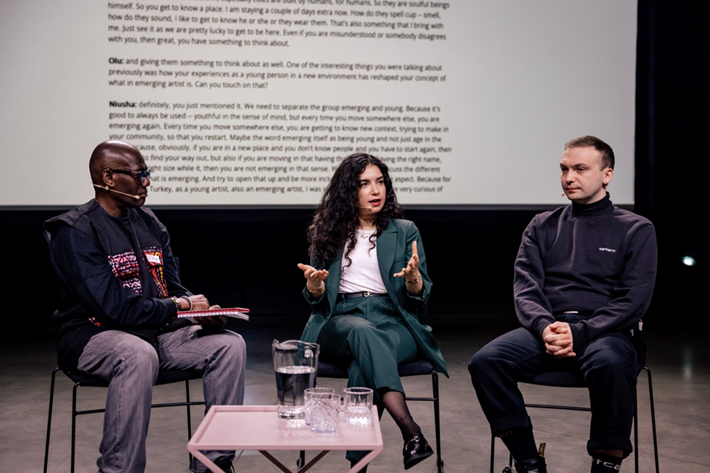
5. Panel 3. 'Points of Departure, Points of Arrival: Young Arts Workers Reviewing International Relations,' featuring Niusha Khanmohammadi (artist, Sweden) and Bahdan Khmialnitski (Goethe-Institut Georgia), with moderator Olu Alake (The Africa Centre, United Kingdom). Photo © Lauris Vīksne
There are several reasons why certain roles cannot be done remotely due to the need for physical presence, social interaction, and the experiential aspects of time and space that are unique to cultural work. A personal example comes from my recent trip to Riga, Latvia, for the forum while simultaneously managing the delivery of an artist’s work from a museum in Jakarta to a storage warehouse in Yogyakarta. While all coordination with museum staff and transport provider was done digitally, handling the artworks required on-site supervision. I had to hire an assistant to replace me in overseeing the storage of 14 large crates. On a broader level, curatorial and research work also often demands physical presence to ensure integrity, depth, and human connection. As a result, arts workers who cannot perform their tasks remotely will automatically lose mobility opportunities.
Cultural mobility is often imagined as an open space for collaboration and idea exchange. In reality, however, many arts workers encounter structural barriers, such as limited funding, visa restrictions, or a lack of institutional support. For non-artists, these challenges might include the difficulty of taking time off work. This is particularly true for arts workers from regions that are underrepresented or excluded from centres of cultural power.
Cultural Mobility Forum 2025: Revisiting the international mobility of young and emerging arts workers
Managing residencies has taught me that cultural work goes beyond administrative work. It is relational work that demand cross-cultural sensitivity, mediation skills, a deep understanding of the local context, and an awareness of the often invisible inequalities in access. The greatest challenge is creating a genuinely equal meeting space for artists, collaborators, local arts communities, host organisations, and other stakeholders involved.
Working with artists from diverse backgrounds also taught me the importance of pausing, listening, and managing expectations. I have come to realise that a successful residency is one that nurtures: it provides not only the necessary facilities but also space to be vulnerable, fail, and try again. This is a form of unwritten knowledge that can only grow through experience and human connection. Unfortunately, this kind of knowledge is often excluded from the dominant concept of professionalism. It could, however, be more widely developed if arts managers and cultural professionals had the opportunity to move and learn from other contexts.
The discussions at the Cultural Mobility Forum 2025 highlighted the growing global awareness of inequalities in cultural mobility.
An inclusive arts ecosystem cannot be built solely on mobility. What is needed is a new form of solidarity — one that is not just symbolic, but structural.
This solidarity must acknowledge that cultural work is collective and that all roles within it, both artists and other stakeholders like arts managers and cultural producers, deserve equal access to learning spaces and opportunities. To truly redefine cultural mobility today, we also need to examine who is given the opportunity to move and who continues to be held back.
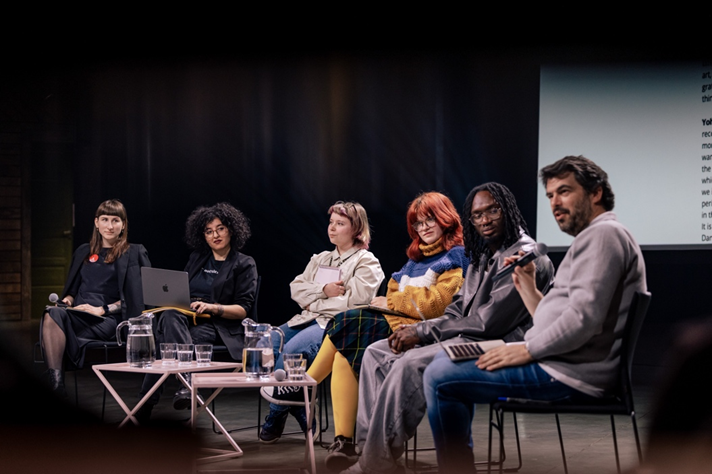
6. Panel 4. Takeaways and recommendations, featuring rapporteurs Clara Passarinho (Portugal), Katrīna Dūka (Latvia), Andrew Ogun (United Kingdom), Ikars Graždanovičs (Latvia), Lina Allia (Algeria), Karu Treij (Latvia), with moderator Yohann Floch (On the Move). Photo © Lauris Vīksne
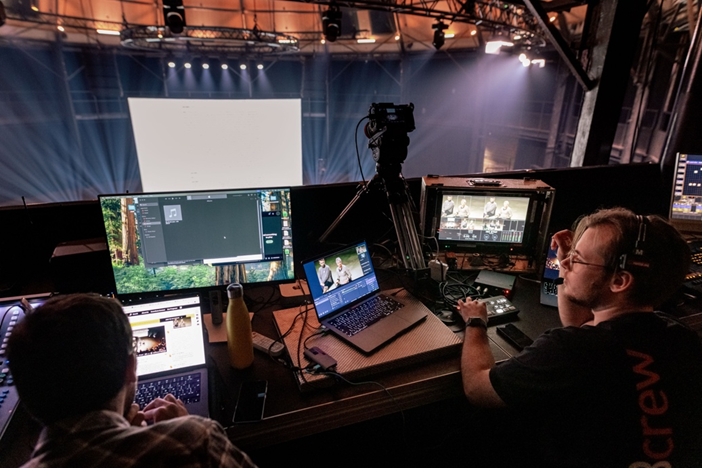
7. A behind the scenes glimpse at the Cultural Mobility Forum 2025. Photo © Lauris Vīksne
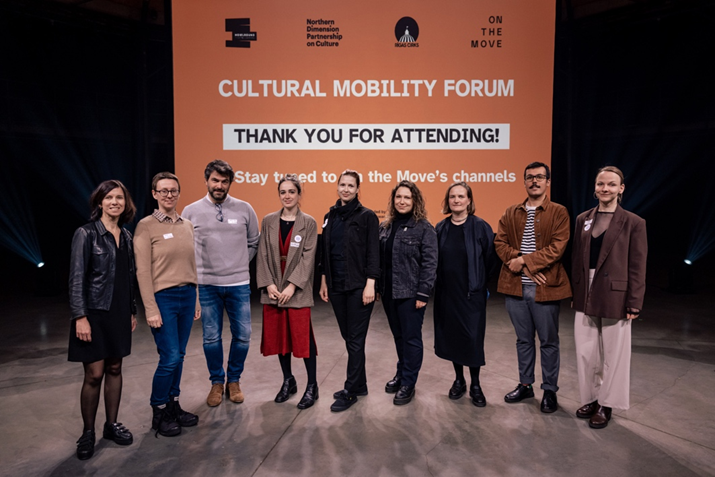
8. On the Move team with partners: Northern Dimension Partnership on Culture, NDPC and VSIA Rigas cirks, who worked their magic behind the scenes. Photo © Lauris Vīksne
About the Author
Theodora Agni is an independent arts manager based in Yogyakarta, Indonesia, with expertise in arts residency. Her work draw inspiration from the role of the dramaturg, as an intermediary and multitasker, guiding her approach to facilitating artistic processes and collaborations. She founded Shifting Realities in 2020 to cultivate critical discourse on arts management, and co-founded after-hours care club, a collective of behind the scenes workers in arts that organises skill-sharing workshops since 2016.
